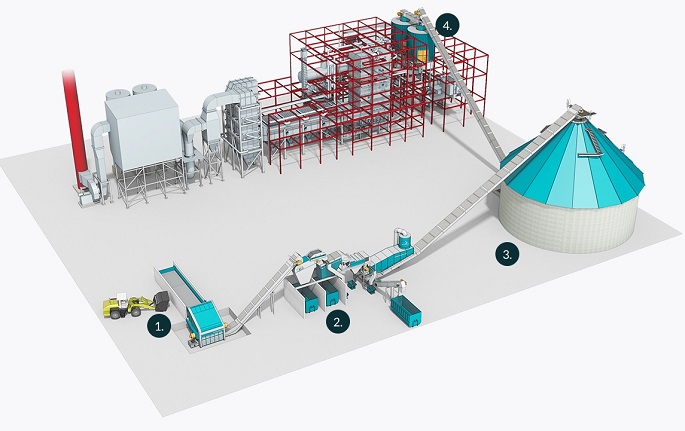Replacing coal with clean energy
Promoting carbon trading- a glimpse of “green capital"
Published : 14 Aug 2019, 23:35
Updated : 15 Aug 2019, 11:46
Finnish southern city of Lahti was named the Green Capital of Europe 2021 in June. It has been a winner of the title with the highest latitude and smallest population since the European Commission established it in 2008.
During a recent visit, Xinhua correspondents quite often heard such a comparison: "We are 10 to 15 years ahead of the capital (Helsinki)."
The pride of the Lahti people is sensible. In the 1980s, industrial sewage discharge caused serious pollution to Lake Vesijarvi. After systematic treatment, the water quality recovered to the level of 100 years ago and thus contributed a world famous case study for lake recovery.
Today, Lahti is once again taking a historic step -- bidding farewell to coal.
FAREWELL TO COAL
Mayor Pekka Timonen said coal has been the main source of energy in Lahti, and a 60 percent consumption of coal remained until March.
Starting in April, Lahti decided to completely abandon coal and totally depend on biomass and sorted waste.
In the compound of the Lahti Energy, the largest power and heat producer in the region of 200,000 population, trucks loaded with wood chips or garbage were seen entering and unloading. Smoke was invisible over the chimney, and one could hardly see any workers moving, no smell, no noise, as if the plant was shut down.
But project manager Esa Tepponen said the boiler was actually running at full capacity. Because of the state-of-the-art design, the combustion is sufficient, and the fly ash is finely filtered, so that the discharge is invisible to the naked eye, he added.
Lahti began turn garbage into energy in 1998. Unlike incinerating mixed waste in other regions, Lahti Energy broke up household waste into solid recovered fuel, or SRF and utilized gasification in the process, which greatly increased combustion efficiency, reduced production costs and minimized environmental risks. Since 2012, the process of producing SRF has been transferred mainly to the Lahti Waste Management Center.
WASTE SORTING
The production of SRF requires citizens to classify garbage well.
More than 30 collecting bins were seen set up inside the waste management center, and a dozen private cars were lined up for entry. A middle-aged man said he drove five kilometers to throw his old furniture. A big sofa caused him 30 euros besides the annual fee. "Finns have long been accustomed to driving the garbage to the collecting center and paying for the treatment," said Jurijs Trosenko, a specialist of the SET Cleantech company.
The level of waste sorting in Lahti is one of the best in Finland. The biological waste is sent to the indoor treatment plant nearby, and the remaining waste is filtered and brought to the SRF production line. After cutting and multiple sorting, the recyclable materials are separated, and the remaining part is made into a high calorific value solid fuel, shipped to the power plant.
Tuula Honkanen, CEO of the waste management center, told Xinhua that 52 percent of domestic waste is burned, 43 percent recycled or degraded, and 5 percent put to landfill.
Faced with this transcript, the city's Environmental Director Saara Vauramo seems to have a higher goal: to continue to increase the level of recycling and reduce the proportion of combustion capacity.
For example, Vauramo said, "plastic bags can be used both as recyclable waste and as combustible waste, but we want to recycle as much as possible before they are burned."
"Plastic is a good fuel, but it is used only once if we burn it. Using modern technology, it can be used repeatedly," she elaborated.
Mayor Timmon said Lahti is determined to achieve carbon neutrality by 2025. The goal of Finland is by 2035, and the EU's goal is by 2045. "We are much ahead," he said to Xinhua.
PERSONAL CARBON TRADING
In order to achieve this ambitious goal, Lahti will make a groundbreaking attempt this year to promote the personal carbon trading system.
This is a mobile app that automatically tracks and identifies how users are traveling. If the user travels in green style and accumulates a certain score, they can get a reward, which may be a free cup of coffee or a movie ticket.
Project leader Anna Huttunen said the system has been in trial for a while and is expected to be officially launched this fall. Lahti will be the first city in the world to establish a local private carbon trading market then.
Looking back at the history of the competition for the title of Green Capital, Timonen believes that this is a rigorous test. "First you have to be eligible, possible to apply. Then you have to go through expert review, 11 different categories, are you really green? Three best are chosen to the final, and an independent expert jury will meet and decide who wins."
"It is very big for Lahti that we are chosen," said Timonen, who believes Lahti now is one of the cities that show the way on sustainable city development and cities that are environmentally conscious, and find few ways on how to move forward.
Hearing that some cities in China are actively setting examples for waste sorting, Timonen said it was exciting. "Cities are both problem and solution. Because most of the people live in cities, and they grow bigger... We need to go forward, we need cities that can show the way."


